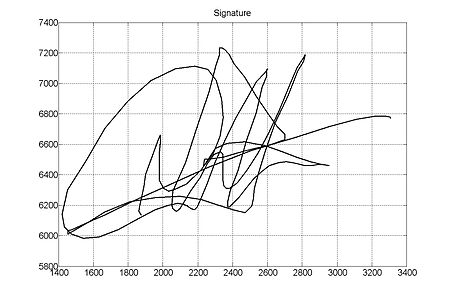

Signature recognition is an example of behavioral biometrics that identifies a person based on their handwriting. It can be operated in two different ways:
Static: In this mode, users write their signature on paper, and after the writing is complete, it is digitized through an optical scanner or a camera to turn the signature image into bits. The biometric system then recognizes the signature analyzing its shape. This group is also known as "off-line".
Dynamic: In this mode, users write their signature in a digitizing tablet, which acquires the signature in real time. Another possibility is the acquisition by means of stylus-operated PDAs. Some systems also operate on smart-phones or tablets with a capacitive screen, where users can sign using a finger or an appropriate pen. Dynamic recognition is also known as "on-line". Dynamic information usually consists of the following information:
- spatial coordinate x(t)
- spatial coordinate y(t)
- pressure p(t)
- azimuth az(t)
- inclination in(t)
- pen up/down
The state-of-the-art in signature recognition can be found in the last major international competition.
The most popular pattern recognition techniques applied for signature recognition are dynamic time warping, hidden Markov models and vector quantization. Combinations of different techniques also exist.
Related techniques
Recently, a handwritten biometric approach has also been proposed. In this case, the user is recognized analyzing his handwritten text (see also Handwritten biometric recognition).
Databases
Several public databases exist, being the most popular ones SVC, and MCYT.
References
- Ismail, M.A.; Gad, Samia (Oct 2000). "Off-line arabic signature recognition and verification". Pattern Recognition. 33 (10): 1727–1740. Bibcode:2000PatRe..33.1727I. doi:10.1016/s0031-3203(99)00047-3. ISSN 0031-3203.
- ^ "Explainer: Signature Recognition | Biometric Update". www.biometricupdate.com. 2016-01-11. Retrieved 2021-04-03.
- Houmani, Nesmaa; A. Mayoue; S. Garcia-Salicetti; B. Dorizzi; M.I. Khalil; M. Mostafa; H. Abbas; Z.T. Kardkovàcs; D. Muramatsu; B. Yanikoglu; A. Kholmatov; M. Martinez-Diaz; J. Fierrez; J. Ortega-Garcia; J. Roure Alcobé; J. Fabregas; M. Faundez-Zanuy; J. M. Pascual-Gaspar; V. Cardeñoso-Payo; C. Vivaracho-Pascual (March 2012). "BioSecure signature evaluation campaign (BSEC'2009): Evaluating online signature algorithms depending on the quality of signatures". Pattern Recognition. 45 (3): 993–1003. Bibcode:2012PatRe..45..993H. doi:10.1016/j.patcog.2011.08.008. S2CID 17863249.
- Faundez-Zanuy, Marcos (2007). "On-line signature recognition based on VQ-DTW". Pattern Recognition. 40 (3): 981–992. Bibcode:2007PatRe..40..981F. doi:10.1016/j.patcog.2006.06.007.
- Chapran, J. (2006). "Biometric Writer Identification: Feature Analysis and Classification". International Journal of Pattern Recognition & Artificial Intelligence. 20 (4): 483–503. doi:10.1142/s0218001406004831.
- Yeung, D. H.; Xiong, Y.; George, S.; Kashi, R.; Matsumoto, T.; Rigoll, G. (2004). "SVC2004: First International Signature Verification Competition". Biometric Authentication. Lecture Notes in Computer Science. Vol. 3072. pp. 16–22. doi:10.1007/978-3-540-25948-0_3. ISBN 978-3-540-22146-3.
- Ortega-Garcia, Javier; J. Fierrez; D. Simon; J. Gonzalez; M. Faúndez-Zanuy; V. Espinosa; A. Satue; I. Hernaez; J.-J. Igarza; C. Vivaracho; D. Escudero; Q.-I. Moro (2003). "MCYT baseline corpus: A bimodal biometric database". IEE Proceedings - Vision, Image, and Signal Processing. 150 (6): 395–401. doi:10.1049/ip-vis:20031078 (inactive 7 December 2024).
{{cite journal}}: CS1 maint: DOI inactive as of December 2024 (link)